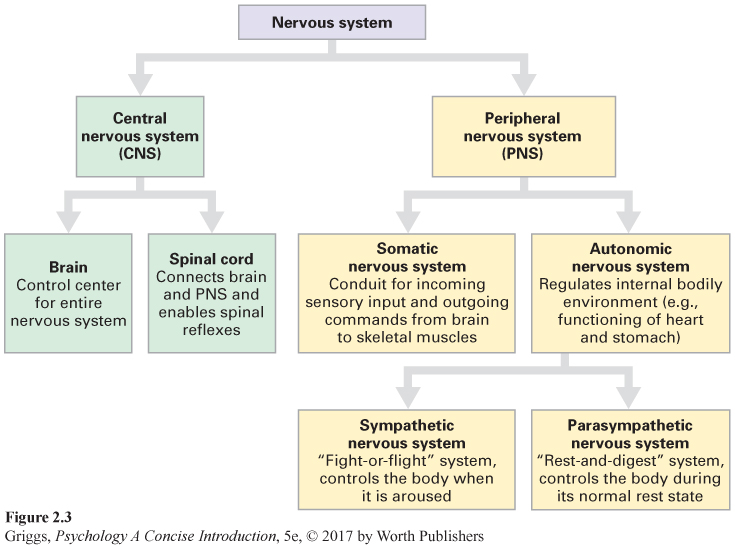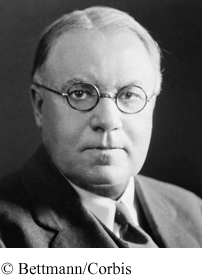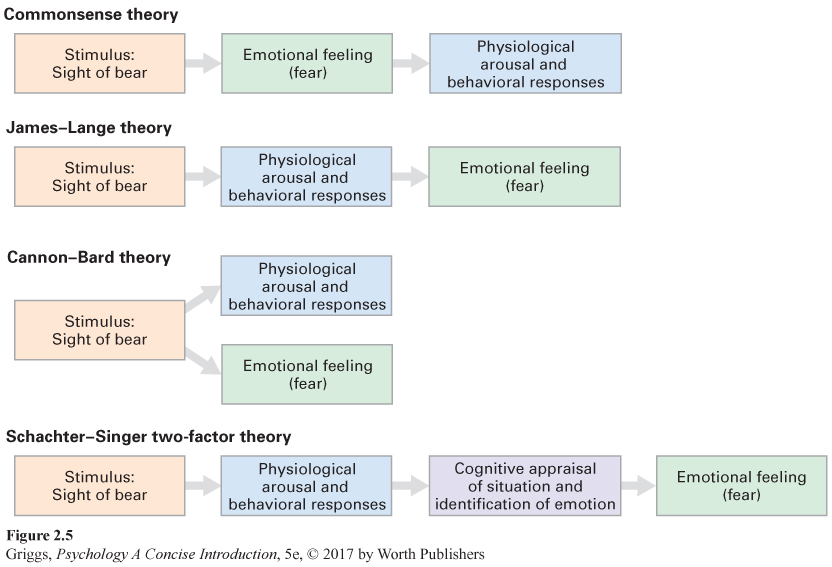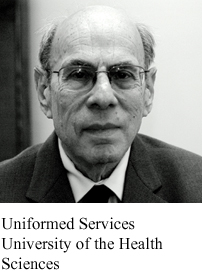2.2 The Nervous System and the Endocrine System
central nervous system (CNS) The brain and spinal cord.
peripheral nervous system (PNS) The part of the nervous system that links the CNS with the body’s sensory receptors, muscles, and glands.
In this section, we will present an overview of the nervous system and the other major communication system of the body, the endocrine glandular system. We will also discuss the three types of neurons in the nervous system. An overview diagram of the major subdivisions of the nervous system is given in Figure 2.3. The two major parts are the central nervous system (CNS), made up of the brain and spinal cord, and the peripheral nervous system (PNS), the remainder of the nervous system throughout the body, linking the CNS with the body’s sensory receptors, muscles, and glands. One part of the peripheral nervous system, the autonomic nervous system, plays an important role in emotional experiences. We will learn how it does so once we learn more about the general nature of the nervous system and its major divisions and the body’s other major communication system, the endocrine glandular system.

interneurons Neurons that integrate information within the CNS through their communication with each other and between sensory and motor neurons in the spinal cord.
sensory neurons Neurons in the PNS that carry information to the CNS from sensory receptors, muscles, and glands.
motor neurons Neurons in the PNS that carry movement commands from the CNS out to the rest of the body.
There are three types of neurons in the nervous system. Interneurons, which integrate information within the CNS by communicating with one another, are only in the CNS. Interneurons also intervene within the spinal cord between sensory and motor neurons that are only in the PNS. Sensory neurons carry information to the CNS from sensory receptors (such as the rods and cones in the eyes), muscles, and glands. Motor neurons carry movement commands from the CNS out to the rest of the body. Bundles of sensory neurons are called sensory nerves. Most enter the CNS through the spinal cord, while some (from the head) enter the brain directly through holes in the cranium (the skull around the brain). Collections of the motor neurons are called motor nerves. They exit the CNS through the spinal cord or, for the head, from the cranium. To begin to understand the role that these neurons play, we’ll next discuss the CNS and the role of the spinal cord.
The Central Nervous System
56
Both parts of the CNS, the spinal cord and the brain, are totally encased in bone—
spinal cord The conduit between the brain and the PNS for incoming sensory data and outgoing movement commands to the muscles.
spinal reflex A simple automatic action of the spinal cord not requiring involvement of the brain, such as the knee-
The spinal cord spans from the stem of the brain down through the neck and the center of the spinal column. It has two main functions. First, it serves as the conduit for both incoming sensory data and outgoing movement commands to the muscles in the body. This is why a spinal cord injury, such as that suffered by actor Christopher Reeve, may result in paralysis and in difficulty breathing. Second, it provides for spinal reflexes. A spinal reflex is a simple automatic action not requiring involvement of the brain. A good example is the knee-
57
For most spinal reflexes, however, interneurons are also involved. Sensory neurons connect with interneurons in the spinal cord, which then connect with motor neurons. The sensory information is also sent up to the brain by way of interneurons, but the brain is usually not involved. A good example of such a spinal reflex is the withdrawal reflex. When we touch something extremely hot or painful, we jerk away. These reflexes normally occur without interference from the brain so that they can occur rapidly. The brain can stop a spinal reflex by sending commands to override the reflexive response, but for obvious reasons it usually chooses not to interfere.
The brain is the control center for the entire nervous system, but it couldn’t perform this job without agents to carry out its commands and to provide information about the activities of the rest of the body and the world outside. We will next discuss the PNS, the system that provides these supportive functions for the brain.
The Peripheral Nervous System
Not only does the PNS gather information for the brain about the external environment and the body’s internal environment through the sensory nerves, it also serves as the conduit for the brain’s commands to the rest of the body through the motor nerves. To carry out these tasks, the PNS has two parts working in concert with each other—
somatic (skeletal) nervous system The part of the PNS that carries sensory input from receptors to the CNS and relays commands from the CNS to skeletal muscles to control their movement.
autonomic nervous system The part of the PNS that regulates the functioning of our internal environment (glands and organs like the heart, lungs, and stomach).
The somatic (skeletal) nervous system carries sensory input from receptors to the CNS and relays commands from the CNS to the skeletal muscles to control their movement. Skeletal muscles are those that are attached to bone, such as the muscles of the arms and legs. As we have already discussed, the primary neurotransmitter for these muscles is acetylcholine. The autonomic nervous system regulates the functioning of our internal environment (glands and organs such as the stomach, lungs, and heart). The somatic nervous system is thought of as voluntary, but the autonomic system is usually thought of as involuntary, operating on automatic (hence the name, autonomic) to maintain our internal functioning such as heartbeat, respiration, and digestion. This is why we are generally unaware of what the autonomic nervous system is doing.
sympathetic nervous system The part of the autonomic nervous system that is in control when we are highly aroused, as in an emergency, and need to prepare for defensive action.
parasympathetic nervous system The part of the autonomic nervous system that returns the body to its normal resting state after having been highly aroused, as in an emergency.
The autonomic system has two parts—
| Sympathetic Nervous System | Parasympathetic Nervous System |
|---|---|
| Dilates pupils | Contracts pupils |
| Contracts blood vessels | Dilates blood vessels |
| Speeds heart rate | Slows heart rate |
| Speeds breathing | Slows breathing |
| Inhibits salivation | Activates salivation |
| Inhibits digestion | Stimulates digestion |
| Activates sweat glands | Inhibits sweat glands |
| The sympathetic and parasympathetic divisions of the autonomic nervous system work together to coordinate our internal functioning, including our heart, stomach, and glandular activity. In general, the sympathetic system arouses and expends energy while the parasympathetic system calms and conserves energy. | |
The Endocrine Glandular System
58
endocrine glandular system The body’s other major communication system. Communication is achieved through hormones that are secreted by the endocrine glands and travel through the bloodstream to their target sites.
The endocrine glandular system, the body’s other major communication system, is not part of the nervous system, but these two systems are connected in order to maintain normal internal functioning. The endocrine glandular system works with the autonomic nervous system in responding to stress, and it also plays an important role in such basic behaviors as having sex and eating and in normal bodily functions, such as metabolism, reproduction, and growth.
59
hormone A chemical messenger that is produced by an endocrine gland and carried by the bloodstream to target tissues throughout the body.
The endocrine glandular system communicates through messengers in the bloodstream. Endocrine glands secrete chemical substances within the body into the bloodstream; exocrine glands (such as sweat and tear glands) secrete substances outside the body. The substances secreted by the endocrine glands are hormones. A hormone is a chemical messenger produced by the endocrine glands and carried by the bloodstream to target sites throughout the body. Some hormones (adrenalin and noradrenalin secreted by the adrenal glands) are chemically similar to some neurotransmitters (epinephrine and norepinephrine), but neurotransmitters are released at their targets (other neurons), while hormones have to travel through the bloodstream to reach their targets. For example, the male sex hormone, testosterone, travels from the male sex glands through the bloodstream to target sites in facial skin to stimulate hair growth.
pituitary gland The most influential gland in the endocrine glandular system. It releases hormones for human growth and hormones that direct other endocrine glands to release their hormones.
The endocrine glandular system is controlled by its connection with a part of the brain called the hypothalamus (to be discussed in the next section). The hypothalamus controls the most influential gland in the endocrine system, the pituitary gland, which releases hormones essential for human growth and also releases hormones that direct other endocrine glands to release their hormones. For example, it is the pituitary gland that directs a male’s sex glands to secrete testosterone. The pituitary gland, located near the base of the brain, thus functions like the master of the endocrine system, which is why it is sometimes referred to as the “master gland.” The hypothalamus, through its control of the pituitary gland, is thus able to regulate the endocrine glandular system.
Other endocrine glands—

Emotions and the Autonomic Nervous System
Most of us experience anger, fear, joy, love, hate, and many other emotions. Emotions play an important part in our lives, and the autonomic nervous system, especially the sympathetic division, plays an important role in how we experience and express emotions. Think about the heightened state of arousal and the bodily feelings that accompany various emotions. For example, we may feel our blood pressure rising, our heart pounding, our body trembling, or butterflies in our stomach. Such bodily arousal and feelings stem from autonomic nervous system activity, which prepares us for our emotional reactions. But exactly what is an emotion, and how do emotions arise?
60
emotion A complex psychological state that involves a state of physiological arousal, an outward behavioral expression of the emotion, and a cognitive appraisal of the situation to determine the specific emotion and its intensity.
The three components of emotion. Psychologists usually define an emotion as a complex psychological state that involves three components: (1) a physical component—
First, let’s consider the physical component of emotion. In emotional situations the autonomic nervous system increases our physiological arousal. The sympathetic nervous system goes into its “fight-
61
The behavioral component of emotion is the product of the somatic nervous system. It provides the nonverbal, expressive behavior for the emotion—
The cognitive component of emotion appraises the situation to determine what emotion we are experiencing. We perceive the changes in bodily arousal and behavioral responses within the situational context, and then, using the knowledge we have stored in memory about emotions, we determine what emotion we are experiencing. For example, if your hands are sweating, you feel butterflies in your stomach, your mouth is dry, and you are about to give a speech to a large crowd, then your brain will easily deduce that you are anxious.
Next, we will consider how this cognitive component interacts with the physical and behavioral components to produce our emotional experiences as we contrast some of the major theories of emotion.




Theories of emotion. Many theories have been proposed over the last century to explain emotion. We’ll consider three of them—
62
James-
American psychologist William James and Danish psychologist Carl Lange developed one of the earliest theories of emotion (Lange & James, 1922). They disagreed with the order of events proposed by the commonsense theory and argued that the emotional feeling does not precede, but rather follows, the physiological arousal and behavioral response. According to the James-
Cannon-
Walter Cannon, the physiologist most responsible for discovering the functions of the autonomic nervous system, had different ideas about the role of arousal in emotion. He and another physiologist, Philip Bard, developed what is called the Cannon-
Schachter-
Subsequent research on these two theories has not strongly supported either one but has indicated that the cognitive component may play a larger role than previously thought. These early theories did not emphasize this component. The last theory of emotion that we will discuss, Stanley Schachter and Jerome Singer’s two-
63

64

Schachter and Singer’s experimental work to test their theory only provided partial support, but their theory has spurred much discussion and research on the role of cognitive appraisal in emotion. As mentioned earlier, the autonomic arousal patterns for some emotions are not the same, but some argue that these pattern differences may be too small to allow the differentiation of most emotions (Lang, 1994). However, these emotions also lead to different patterns of brain activity (Damasio et al., 2000). Could these patterns be used to differentiate emotions?

To help resolve this question, Joseph LeDoux (1996, 2000) proposes that there are different brain systems for different emotions. Some emotional responses might be the product of a brain system that operates as a reflex system without cognitive appraisal. Fear is probably such an emotion. LeDoux actually has some evidence that the fear response can be generated almost instantaneously—
Other emotions, however, may entail using a brain system that relies on cognitive appraisal and the use of past emotional experiences in this appraisal. This system would be responsible for more complex emotions, such as love or guilt, that do not require an instant response. In sum, this theory not only accommodates much of what we know about emotion but also provides a general framework for research on the roles of various brain structures in generating our emotions. We now turn to a discussion of these brain structures and what we presently know about them and their roles not only in emotion but also in thought, language, memory, and the many other information-
Section Summary
In this section, we discussed the two major communication systems within the body—
The PNS has two parts that work in concert with each other—
65
The endocrine glandular system is not part of the nervous system, but the two systems work together to maintain normal internal functioning. The endocrine glandular system plays an important role in many basic behaviors, such as eating and having sex, and normal bodily functions, such as metabolism, growth, and reproduction. The brain controls the endocrine glandular system through the hypothalamus, which controls the master gland within the system, the pituitary gland.
We also discussed how the autonomic nervous system plays a critical role in the physical component of our emotional experiences by triggering a state of physiological arousal, which prepares us for our emotional reactions. An emotion is the result of the interplay between this physical component, a behavioral component (the outward expression of the emotion), and a cognitive component (an appraisal of the entire situation to determine which emotion we are experiencing). The major explanations of emotion have varied in the proposed relationships among these three components, as well as their importance. More recent theories of emotion, such as Schachter and Singer’s two-
2
Question 2.5
.
Explain the differences between sensory neurons, motor neurons, and interneurons with respect to location and function.
With respect to location, sensory neurons and motor neurons are only in the PNS, and interneurons are only in the CNS. With respect to function, sensory neurons carry information to the CNS from the sensory receptors and internal organs, muscles, and glands of the body. Motor neurons carry movement commands from the CNS out to the rest of the body. Interneurons integrate the information within the CNS.
Question 2.6
.
Explain why the sympathetic nervous system has been referred to as the “fight-
The sympathetic nervous system is referred to as the “fight-
Question 2.7
.
Explain how hormones differ from neurotransmitters. Explain why the pituitary gland is referred to as the “master gland.”
Both hormones and neurotransmitters are chemical messengers, but the hormones are much slower because they carry their message through the bloodstream to their distant targets. Neurotransmitters are released within the nervous system directly to their targets.
The pituitary gland is referred to as the “master gland” because it releases hormones that direct the other endocrine glands to release their hormones. It functions like the master of the endocrine system.
Question 2.8
.
Explain how the James-
According to the James-